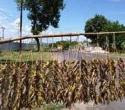YOGYAKARTA (often also called Jogja, Yogya, or Yogyakarta) is located in the middle of Java Island - Indonesia, where everything was cheap.Enough with the Rp.200.000 a day, you can stay, eat traditional cuisine of the famous, and rent a bike to explore the beaches are still virgin and ancient temples thousands of years old.
Borobudur
This is what founded the Kingdom of Borobudur temple which is the largest Buddhist temple in the world, 300 years before Angkor Wat in Cambodia. Other relics are the temple of Prambanan, Ratu Boko Palace, and dozens of other temples that have been restored and are still buried under the ground.
But by some mysterious reason, the Ancient Mataram Kingdom central government moved to East Java in the 10th century.Magnificent temples were abandoned and partially buried by the eruption of Mount Merapi material.Slowly, the Yogyakarta region went back into the thick forest.
Six hundred years later, Panembahan Senopati establish Islamic Mataram kingdom in this region. Once again Yogyakarta to witness the history of empire that controls the island of Java and its surroundings. Islamic Mataram Kingdom has left a trail of ruins of the citadel and royal tombs in Kotagede now known as a center for silver in Yogyakarta
Puppet Show
Giyanti agreement in 1755 dividing the kingdom of Mataram Islam became Kasunan Surakarta, based in the city of Solo and Yogyakarta Sultanate who founded the palace in the city of Yogyakarta. Kraton (palace) was still standing until now and still serves as a residence sultan and his family, complete with hundreds of courtiers who voluntarily run a tradition in the midst of changing times. At the palace, every day there are cultural performances of wayang kulit performances, gamelan, Javanese dance, etc. (see Schedule of Events).
Yogyakarta at the present is a place of tradition and modern dynamics go hand in hand. In Yogyakarta there are courts with hundreds of courtiers loyal to the tradition, but also there is the University of Gadjah Mada University, which is one of the leading universities in Southeast Asia. In Yogyakarta, some people living in an agrarian culture is thick, but there are also the student with life-style pop. In Yogyakarta there are traditional markets and handicrafts while standing next to the mall, no less hectic.
Beach Sundak
At the north end of Yogyakarta, you will see Mount Merapi stands proudly as high as 9738 feet. This mountain is one of the most active volcanoes in Indonesia. Traces the fierce eruption of Mount Merapi in 2006 and can be witnessed in the village of Kaliadem, 30 km from the city of Yogyakarta. Landscape style Mooi Indië green expanse of rice fields and Mount Merapi in the background can still be seen on the outskirts of the city of Yogyakarta.
In the southern part of Yogyakarta, you will find many beaches. The most famous beach is Parangtritis with legend Nyi Roro Kidul, Yogyakarta but also has natural beaches in Gunung Kidul beautiful. You can see Sadeng which is a primordial Solo River estuary before a powerful tectonic forces lifted the surface of the southern island of Java so that the flow of the river turned to the north like today. You also can visit the beach which has 250 channels Siung rock climbing, Beach Sundak, and others (see Beaches).
Malaysia has the world's tallest twin towers, Prambanan Temple Yogyakarta has a towering 47 meters tall and is made by hand 1100 years earlier. Singapore has a modern life, Yogyakarta has a traditional agrarian society. Thailand and Bali has beautiful beaches, Yogyakarta has natural beaches and Mount Merapi, which saves the story of how powerful the forces of nature.
A unique combination of ancient temples, history, tradition, culture, and the forces of nature make Yogyakarta is well worth a visit. diytransport.blogspot.com sites will help you plan a visit to Yogyakarta and enjoy the best charm of this place. We provide abundant information about the sights, star hotels, cheap hotels, restaurants, food stalls, travel agents, rental car and all the information you need to travel to Yogyakarta / Jogja.
 contact at 0274- 6823300; 081.754.21261; 081.3280.32500; pin bb : 2A9FFE7D
contact at 0274- 6823300; 081.754.21261; 081.3280.32500; pin bb : 2A9FFE7D
 Belalang atau dalam bahasa jawa disebut walang merupakan serangga herbivora dari sub-ordo Caelifera dalam ordo Orthoptera. Belalang yang merupakan serangga bebas pada awalnya merupakan hama bagi tanaman. Namun di Gunungkidul, belalang diolah menjadi makanan khas kaya gizi. Bahkan belalang (belalang kayu)mempunyai kandungan protein yang lebih tinggi dari pada udang windu.
Belalang atau dalam bahasa jawa disebut walang merupakan serangga herbivora dari sub-ordo Caelifera dalam ordo Orthoptera. Belalang yang merupakan serangga bebas pada awalnya merupakan hama bagi tanaman. Namun di Gunungkidul, belalang diolah menjadi makanan khas kaya gizi. Bahkan belalang (belalang kayu)mempunyai kandungan protein yang lebih tinggi dari pada udang windu. Belalang, menjadi makanan khas Gunungkidul yang selalu dicari para perantau asal Gunungkidul saat mudik, baik untuk dimakan sendiri maupun untuk oleh-oleh. Belalang yang telah dimasak bisa tahan sampai satu minggu. Tidak susah untuk mendapatkan belalang. Di pinggir-pinggir jalan saat sore mulai merayap banyak ditemui belalang yang dipajang dengan sebilah bambu untuk ditawarkan. Tentu saja belalang di sini masih mentah. Namun jika menginginkan belalang yang sudah di masak, silahkan kunjungi pusat penjualan oleh-oleh di Gunungkidul atau pun pasar-pasar tradisional. Di sana dijajakan belalang masak dengan berbagai rasa tergantung selera, manis,
Belalang, menjadi makanan khas Gunungkidul yang selalu dicari para perantau asal Gunungkidul saat mudik, baik untuk dimakan sendiri maupun untuk oleh-oleh. Belalang yang telah dimasak bisa tahan sampai satu minggu. Tidak susah untuk mendapatkan belalang. Di pinggir-pinggir jalan saat sore mulai merayap banyak ditemui belalang yang dipajang dengan sebilah bambu untuk ditawarkan. Tentu saja belalang di sini masih mentah. Namun jika menginginkan belalang yang sudah di masak, silahkan kunjungi pusat penjualan oleh-oleh di Gunungkidul atau pun pasar-pasar tradisional. Di sana dijajakan belalang masak dengan berbagai rasa tergantung selera, manis,  asin, gurih dan pedas.
asin, gurih dan pedas.
Tidak ada komentar:
Posting Komentar